June 2005 LIP of the Month
Corresponds to event #141 in LIP record database.
The Xiong’er Group: A 1.76 Ga Large Igneous Province in East-Central China?
Franco Pirajno
Geological Survey of Western Australia, 100 Plain Street, Perth WA 6004, Australia
franco.pirajno@doir.wa.gov.au
Yanjing Chen
Institute of Geochemistry, Chinese Academy of Sciences, Guiyang 550002, China
and Dept. of Geology Peking University, Beijing 100871, China
Introduction
The Palaeoproterozoic Xiong’er Group, lies at border between Shaanxi, Shanxi and Henan provinces, with Sanmenxia city, roughly in the middle and the historical ancient capital of Xi’an in the west (Figs. 1 and 2).
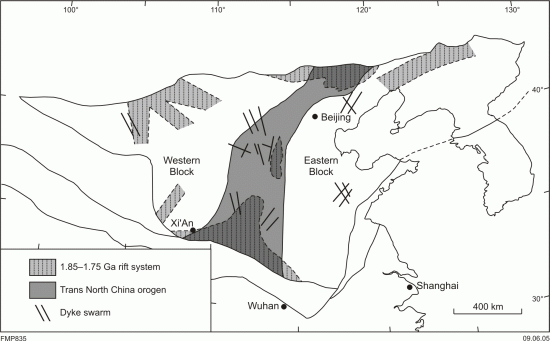
Figure 1: Simplified tectonic map of the North China Craton, showing the Xiong’er rift and schematic trend of dyke swarms. Modified from Zhao et al. (2005) and Peng et al. (2005).
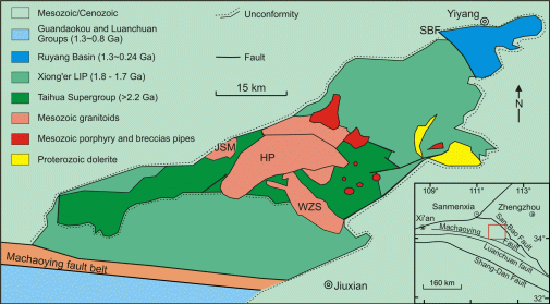
Figure 2: Simplified geology of the Xiong’er terrane, at the southern margin of the North China Craton. After Chen et al. (2004).
The Xiong’er Group was deposited in a three-arm rift system with its three branches trending approximately WSW, SE and NE (Fig. 1). The Xiong’er three-arm rift system is situated within the Trans-North China Orogenic Belt, which separates the Eastern and Western blocks of the North China Craton (Zhao et al., 2002, 2004, 2005; Kusky and Li, 2003). The two southern branches (WSW and SE) are within the Huaxiong block that was interpreted to be the northernmost tectonic unit of the Qinling mountains of central China, or the southernmost unit of the North China craton (Chen et al., 2004). The NE branch, usually referred to as Xiyanghe Group, is along the boundary between the Songji and Zhongtiao blocks and is the third failed arm of the rift system. The Xiong’er rift was formed along zones of pre-existing structural weaknesses, namely the Trans-North China orogen and the southern margin of the North China Craton (Fig. 1). The Xiong’er Group is mostly developed in the Xiong’er terrane of the Huaxiong Block, bounded to the south by the Luanchuan fault and to the north by the San-Bao fault. A simplified geological map of the Xiong’er Terrane is shown in Fig. 2. The Xiong’er Terrane contains two main lithostratigraphic units: the Late Archean-Paleoproterozoic Taihua Supergroup and the overlying Xiong’er Group. The Terrane is intruded by a suite of granitoids of Jurassic-Cretaceous age (Yanshanian orogeny; Fig. 2). The EW-trending Machaoying fault (Fig. 2), with a strike of over 200 km and inferred depth of 34-38 km, has been interpreted as a major north-dipping thrust or A-type subduction zone formed during Mesozoic continental collision (Chen et al., 2004). The Taihua Supergroup is a high-grade metamorphic sequence of amphibolite to granulite facies rocks comprising the Beizi Group greenstone belt (>2.5 Ga), the Dangzehe greenstone belt (2.55~2.3 Ga) and the passive margin succession of graphite schist, marble and iron-formation rocks of the Shuidigou Group (2.3~2.2 Ga) (Chen et al., 2004 and references therein).
In this contribution we review the geochronology, petrography, and geochemistry integrated with field observations of the Xiong’er Group. The tectonic setting of the Xiong’er Group is somewhat contentious but we conclude, in agreement with other researchers, that the Xiong’er Group may represent the remnants of an ancient large igneous province (LIP) emplaced at a triple junction that was developed along the southern margin of the North China Craton at about 1.8 Ga.
The Xiong’er Group
Stratigraphy and age constraints
The Xiong’er Group, with thicknesses ranging from 3 to 7.6 km and an inferred present day areal extent of about 60 000 km2 (Zhao et al. 2002), is a well-preserved unmetamorphosed, only locally deformed, predominantly volcanic sequence that unconformably overlies the metamorphic basement (Taihua Supergroup) and is overlain by Mesoproterozoic clastic and carbonate rocks of the Ruyang Group and Guandakou Group. The volcanic rocks include a variety of types such as basaltic andesite, andesite, trachyandesite, dacite, rhyodacite and rhyolite, with minor sedimentary intercalations and pyroclastic units. Zhao et al. 2002 divided the Xiong’er Group into four formations, which from bottom to top include: Dagushi, Xushan, Jidanping and Majiahe. The Dagushi Formation is a basal terrigenous clastic sedimentary unit. The Xushan Formation contains lava flows of basaltic andesite, andesite, trachyandesite; the Jidanping Formation has predominantly felsic units (dacite-rhyodacite-rhyolite) at the base followed by basaltic andesite, overlain by more felsic rocks; the Majiahe Formation comprises basaltic andesite with intercalations of sedimentary rocks. Zhao et al. (2002) recognised two main cycles of volcanism. The first cycle is from mafic to felsic and represented by the Xushan and Jindanping formations; the second cycle, represented by the Majaihe Formation is early basaltic to late andesitic. However, it is not clear if and how much of the topmost Majahe Formation has been lost to erosion. Also, as shown in Figure 3, the cycles of the volcanic succession could be reinterpreted as a series of mafic-felsic couplets, in which case the present lithostratigraphic subdivisions would need revision. This is supported by field visits to the area, and the volcanic lithostratigraphic succession could be redefined as at least three mafic-felsic cycles, as follows: first cycle basaltic andesite-felsic rocks (Xushan Fm), second cycle basaltic andesite-felsic rocks (Jindanping Fm), third cycle basaltic andesite and intercalated sedimentary rocks (Fig. 3).
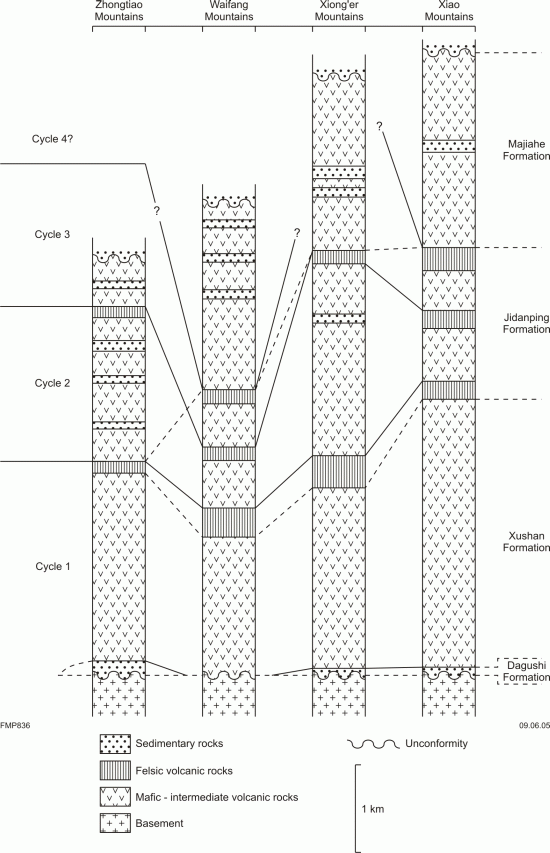
Figure 3: Stratigraphy of the Xiong’er Group volcanic rocks from four localities (after Zhao et al., 2002) and possible subdivision based on mafic-felsic couplets to form 4 cycles.
This aspect is wanting and could only be resolved by detailed field work aimed at the recognition of volcanic centres The topmost Majahe Formation is probably erosion-truncated because it is unconformably overlain by clastic sedimentary rocks of the Ruyang Group..
The age of the Xiong’er Group is not well constrained. A single and multigrain zircon populations (Sun et al. 1990, 1991), including SHRIMP U-Pb ages obtained from rhyolitic rocks as follows: 1826±32 Ma from a single zircon, 1840±14 Ma from sixteen zircon grains. More recently, Zhao et al. (2002) calculated an age of 1.76 Ga from Sm/Nd isotopic data. These authors reported eNd (t = 1.76 Ga) values from –4.5 to –9.3, reflecting a primary magma source. Swarms of mafic dykes are present in the North China Craton. SHRIMP ages of zircon populations range from 2147±5 to 1778±3 Ma (Peng et al., 2005). These zircons belong to one of the swarms of dykes, which are thought to be part of a mantle plume even at 1830-1750 Ma and could conceivably be the feeders to the Xiong’er lava flows (Peng et al., 2005;Wang et al., 2004).
Field observations and petrography
Zhao et al. (2002) broadly divided the Xiong’er volcanic rocks into andesitic and rhyolitic. The former usually forming massive well-jointed flows (Fig. 4), commonly porphyritic and with amygdales filled with chlorite, quartz, epidote and calcite.
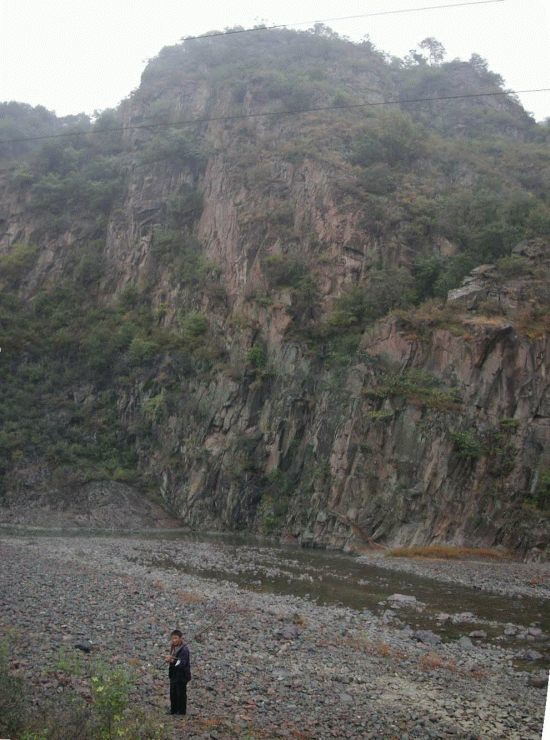
Figure 4a: outcrops of Xiong’er volcanics, columnar-jointed basalt (bottom), overlain by felsic lavas.
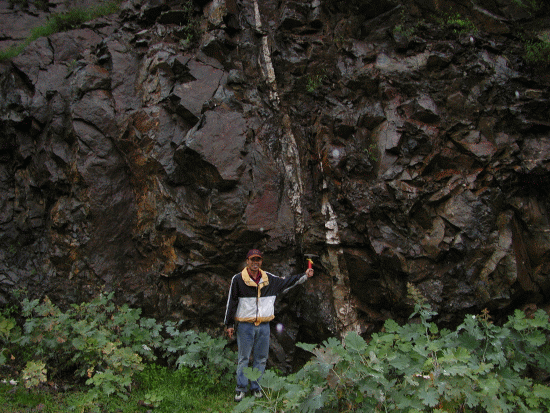
Figure 4b: outcrops of massive basaltic andesite cut by quartz veins, near the Tieluping Ag mine; Prof. Chen Yanjing of Peking University in the photograph
The rhyolitic rocks, which include dacite, rhyodacite and rhyolites, are porphyritic to aphanitic, massive and locally featureless, but locally exhibit well-developed flow banding and lithophysae (Fig. 5).
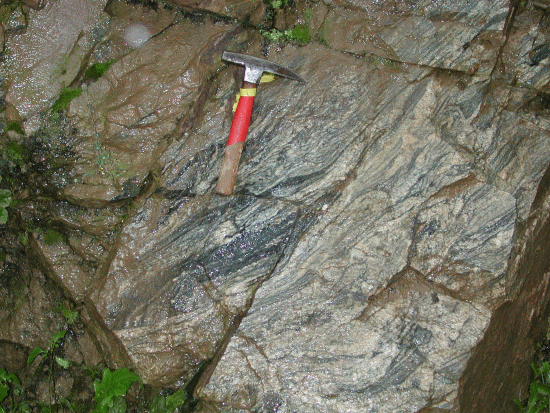
Figure 5: flow-banded dacitic lavas, lower parts of the Jidanping Formation glomeroporphyritic basaltic andesite of the Xushan Formation
Lamprophyre and granitic dykes, dioritic and gabbroic rocks intrude the lavas, but their absolute ages are not known and many of these intrusions could belong to later events (e. g. Mesozoic Yanshanian). The lava flows have no sedimentary intercalations, except for the topmost formations. The contact between lava flows is marked by amygdaloidal tops.
Basaltic andesitic rocks of the Xushan Formation typically contain plagioclase and pyroxene phenocrysts in a fine-grained intersertal matrix composed of plagioclase microlites and pyroxene granules. Notably the phenocrysts are commonly selectively altered to chlorite and epidote. The amygdales show two generations of blue-purple Fe-rich chlorite. Zhao et al. (2002) reported the presence of olivine pseudomorphs in places. The felsic rocks of the Jindanping Formation are characterised by glomeroporphyritic textures with bunches of plagioclase crystals up to 5-6 mm across (Fig. 6), and embayed quartz in a felsitic groundmass of quartz and feldspar.
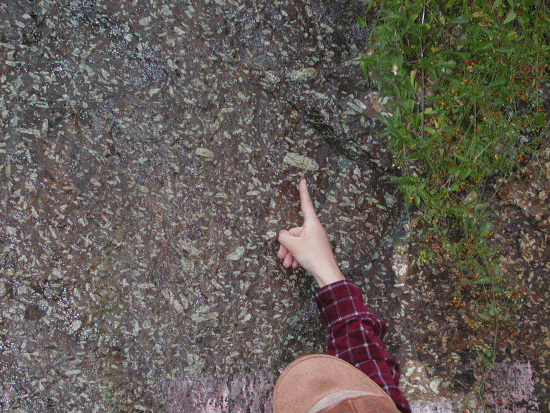
Figure 6: Glomeroporphyritic felsic lavas of the Jindanping Formation.
The phenocrysts are commonly altered to chlorite, calcite, sericite and probably celadonite, indicative of submarine weathering; Haymon et al., 2005). In the basaltic rocks of the Jindaping formation, quench textures are observed and are expecially evident as skeletal plagioclase crystals. The mafic lavas of the Majiahe Formation have a microporhyritic texture with chlorite-replaced pyroxene phenocrysts set in an intersertal to intergranular matrix of plagioclase microlites and pyroxenes. Plagioclase and pyroxene are usually replaced by chlorite, epidote and calcite. In places, plagioclase exhibits skeletal quench textures.
Geochemistry
The geochemistry of the Xiong’er Group volcanic rocks has been investigated by Jia, (1987), Chen (1996) and Zhao et al. (2002). On the basis of these geochemical studies, Jia (1987) suggested that the Xiong’er volcanics originated in a subduction-related volcanic arc; Chen (1996) recognised mixed signatures in terms of differentiation indeces, which he attributed to partial melting of subducted oceanic crust and mantle sources, as well as contributions from continental crust. Zhao et al. (2002) on the other hand using chondrite-normalised multielement and REE plots suggested that the Xiong’er Group was formed in a continental rift setting.
In our work so far, we have used published geochemical data from Zhao et al. (2002) on the Xiong’er Group volcanics, as well as data from the Taihang Mountains mafic dyke swarm from Wang et al. (2004). These dykes belong to a 1.8 Ga thermal event that affected the North China Craton and have been linked to the breakup of the Columbia supercontinent (Zhao et al., 2002; Peng et al., 2005). Peng et al. (2005) suggested that some of these dykes could have fed the Xiong’er volcanism.
In silica versus alkalies diagrams, the Xiong’er volcanic rocks and the Taihang dykes plot in the subalkaline field and have a distinct bimodal trend (Fig. 7).
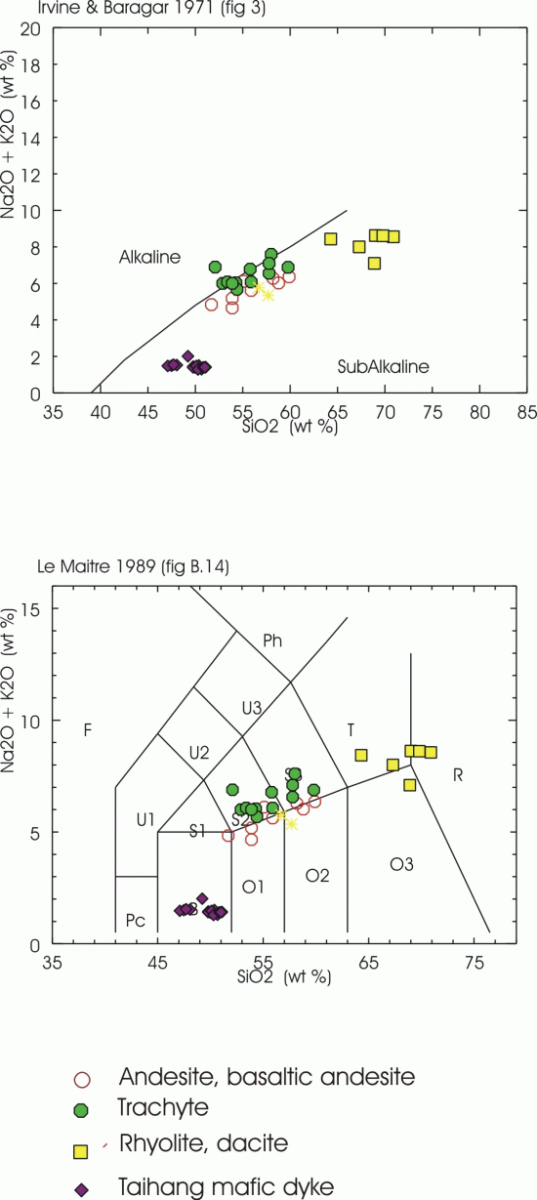
Figure 7: Alkalies versus silica plots (Irvine and Baragar, 1971; Le Maitre, 1989) showing bimodal composition of the Xiong’er volcanic rocks and Taihang mafic dykes. See text for details.
In both these diagrams the Taihang mafic dykes occupy a field distinct from the Xiong’er volcanic rocks. The bimodality of the Xiong’er Group and their separation from the Taihang dykes is also highlighted in the silica versus magnesia diagram (Fig. 8).
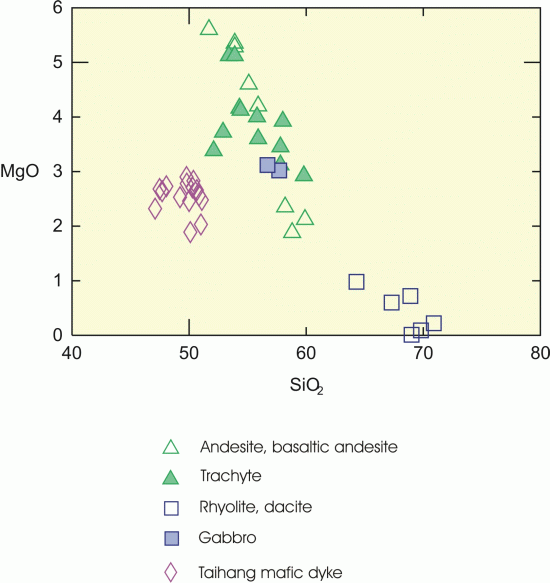
Figure 8: Silica versus magnesia plot showing a distinct bimodal nature of the Xiong’er volcanic rocks.
Discriminant plots of tectonic settings show that the Xiong’er volcanic rocks plot well in the within-plate field, whereas the Taihang dykes overlap with the mid-ocean ridge and island arc basalts (Fig. 9).
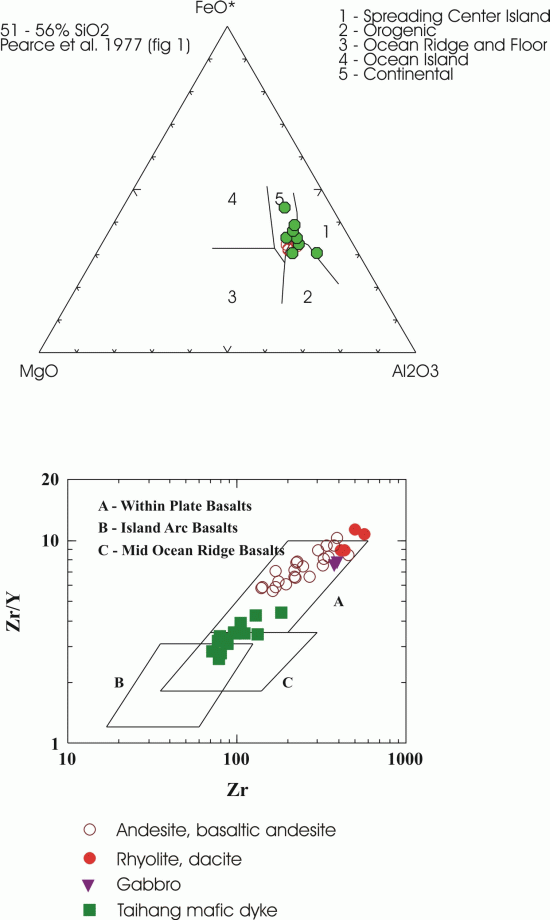
Figure 9: Tectonic discriminant diagrams (Pearce et al., 1977; Pearce et al., 1973); the latter (bottom diagram) was shown by Jiao (1987) , who incorrectly labelled field A as oceanic volcanic arc.
Plots of rare earth elements (REE) normalised to chondrite and multielements normalised to primitive mantle of the Xiong’er volcanics are shown in Fig. 10 and compared with the Emeishan continental flood basalts (Xiao et al., 2003) and the East China-Mongolia alkali basalts (Barry et al., 2003).
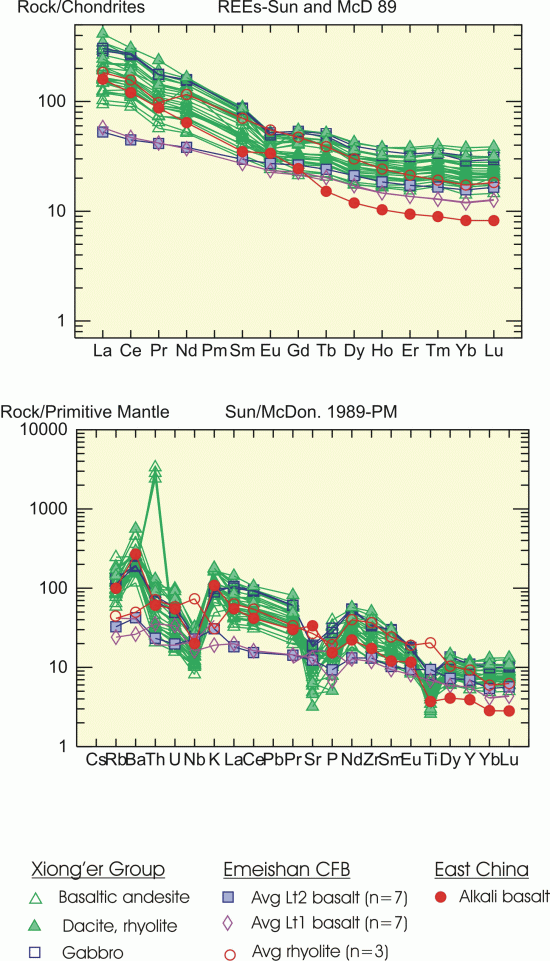
Figure 10: Chondrite-normalised rare earth elements and primitive mantle normalised multielement diagrams for Xiong’er Group, low-titanium (Lt1 and Lt2) Emeishan continental flood basalts (data from Xiao et al. 2003) and East China alkali basalts (data from Barry et al., 2003; normalising factors from Sun and McDonough, 1989).
The REE pattern of the Xiong’er volcanic rocks is almost identical to that of the Emeishan and North East China basalts, all exhibiting a moderate LREE enrichement. The multielement spider diagram (Fig. 10) is suggestive of a subduction modified mantle source for the Xiong’er volcanics, the Emeishan and North East China basalts.
The Xiong’er Group: a 1.76 Ga large igneous province? Discussion
The origin and tectonic setting of the Xiong’er Group volcanic rocks have been controversial. Jia (1987), Sun et al. (1990), Chen (1996) and Zhao et al. (2004) suggested that the Xiong’er Group was part of an Andean type continental arc system that developed along the southern margin of the North China Craton, by the north-dipping subduction of oceanic lithosphere. Sun et al. (1981), Kusky and Li (2003), on the other hand, suggested that the Xiong’er volcanic rocks are a bimodal succession formed in a NE-trending rift system related to the opening of the Qinling ocean. Chen et al. (1992) argued that the Xiong’er Group formed in a continental arc, whereas the Xiyanghe Group in a passive rift developed coevally with the arc. Based on comprehensive geochemical and petrographic data, Zhao et al. (2002) suggested that the Xiong’er Group volcanics are continental flood basalts, derived from an enriched mantle source and modified by crustal contamination. Zhou et al. (2002), in discussing magmatic Ni-Cu-PGE deposits in China, specifically referred to the Xiong’er volcanic succession as a Large Igneous Province (LIP). Peng et al. (2005) working on the geochronology of dyke swarms in the North China Craton, identified four dyke suites with SHRIMP U-Pb ages of 2147±5 Ma, 1929±8 Ma, 1834±5 Ma and 1778±3 Ma. On the basis of this geochronology, Peng et al. (2005) suggested that the older group of dyke suites could relate to the amalgamation of the North China Craton to the Columbia supercontinent (Rogers and Santosh, 2002), whereas the younger suites are related to the breakup of Columbia and a mantle plume event at 1830-1750 Ma. Peng et al. (2004 and 2005) also mentioned that Zhou et al. (2000) and Zhao et al. (2002) had speculated that dykes emplaced during or after 1800 Ma could be genetically related with the volcanics of the Xiong’er Group. This mantle plume would have been implicated in a triple-junction rifting at the southern margin of the North China Craton at ca. 1.78 Ga, leading to its breakup from the Dharwar Craton in India (Peng et al., 2005; Fig. 11).
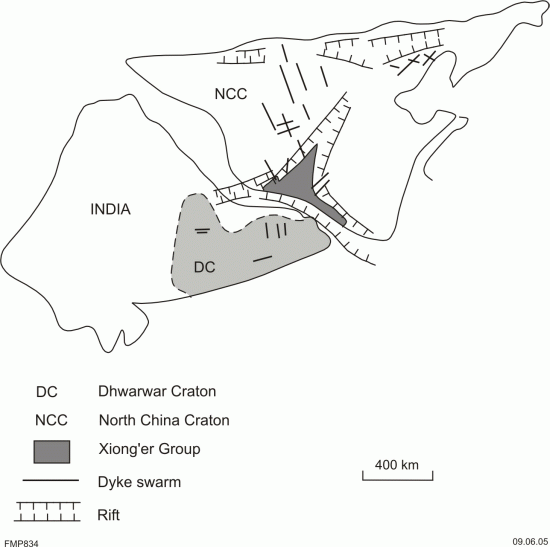
Figure 11: A possible join between the Dharwar Craton and the North China Craton prior to breakup and postulated three-arm Xiong’er rift system (from Peng et al., 2005).
The geochemical data do not support a cogenetic link between the Taihang dykes and the Xiong’er Group. Instead the REE patterns and multielement plot confirm the intracontinental setting of the Xiong’er volcanic rocks.
The interpretations of Zhao et al. (2002) and Zhou et al. (2002) are supported by our field observations (Pirajno and Chen, unpublished data and in prep.) as well as the regional tectonic setting and the age of associated intrusive rocks, as briefly discussed below.
A number of extensional structures (aulacogens and rift basins) were formed along the margins and in the central parts of the North China Craton between 1.85 and 1.7 Ga (Lu et al., 2002; Kusky and Li, 2003). One of these is the three-arm Xiong’er rift, with its NE branch being an aulacogen, a failed rift arm of a triple junction. Mafic dyke swarms of the same age range, trending NW and NNE (Figs. 1 and 13), were emplaced in the Craton (Lu et al., 2002; Kusky and Li, 2003). 40Ar/39Ar geochronology of mafic dykes in the Taihang region, within the Central Orogenic Zone, and just north of the Xiong’er terrane yielded plateau ages of 1780, 1765 and 1774 Ma (Wang et al., 2004; also listed as no. 141 event by Ernst and Buchan, 2001). These ages are within experimental error of the 1.76 Ga Sm/Nd age reported for the Xiong’er volcanic rocks by Zhao et al. (2002). Anorthosite and rapakivi granites of the same age have also been reported from the region (Lu et al., 2002). Some mafic and ultramafic intrusions elsewhere in the North China Craton also have ages of around 1.75 Ga (e. g. Damiao complex with Cu-Ni and V-Ti deposits, Zhou et al., 2002). However, the geochronology of the volcanics and dykes suggest that they are coeval, but on the basis of geochemical data presented above they do not appear to be cogenetic.
The evidence so far available indicates that the Xiong’er Group should be included in the list of Large Igneous Provinces. Its real extent is not known with certainty, mainly because 1) the region is mountainous and heavily vegetated and 2) erosion may have eliminated a substantial part of the succession (see Fig. 3). There are limited data on the volcanics and much remains to be done to map and study associated intrusives, some of which may be prospective for magmatic and/or hydrothermal ore deposits. The study of the Xiong’er Group as a LIP would provide further insights on world-wide ca 1.76-1.8 Ga thermal events (e. g. Uruguayan, Epsinnhacao in Brazil, Dubois-Cochetopa in Colorado, and the Hart event in the Kimberley Basin of Western Australia; see Ernst and Buchan, 2001, for listing and references) and their possible link to mantle plumes or superplume and their role in the breakup of the Columbia supercontinent.
Acknowledgments
Prof. Shihong Zhang of China University of Geosciences in Beijing (CUGB) is thanked for leading a field trip with FP in the Xiong’er region in 2004. Yiguy Han (Xiao Han), PhD student from CUGB provided samples for petrographic studies.
References
Barry, T. L., Saunders, A. D., Kempton, P. D., Windley, B. F., Pringle, M. S., Dorjnamjaa, D., Saandar, S., 2003. Petrogenesis of Cenozoic basalts from Mongolia: evidence for the role of asthenospheric versus metasomatised lithospheric mantle sources. Journal of Petrology, 44: 55-91.
Chen, Y-J., 1996. A new understanding on the relation between natures of volcanic formation and tectonic setting: implication of the study on the Xiong’er Group and its comparison of DI-histograms with typical volcanic formations of the world. Contributions to the 30th International Geological Congress, Beijing, China Petroleum Industry Press: 134-143.
Chen, Y-J., Fu, S-G., Qiang, L-Z., 1992. The tectonic environment for the formation of the Xiong'er Group and the Xiyanghe Group. Geological Review (in Chinese), 38(4): 325-333.
Chen, Y-J. Pirajno, F., Sui, Y-H. 2004. Isotope geochemistry of the Tieluping silver-lead deposit, Henan, China: a case study of orogenic silver-dominated deposits and related tectonic setting. Mineralium Deposita, 39:560-575.
Haymon, R. M., Macdonald, K. C., Benjamin, S. B., Ehrhardt, C. J., 2005. Manifestations of hydrothermal discharge from young abyssal hills on the fast-spreading East Pacific rise flank. Geology, v. 33, p. 153-156.
Irvine, T. N., Baragar, W. R. A., 1971. A guide to the chemical classification of the common volcanic rocks. Canadian Journal of Earth Sciences, 8: 523-548.
Jia, C-Z., 1987. Geochemistry and tectonics of the Xiong’er group in the eastern Qinling mountains of China – a mid-Proterozoic volcanic arc related to plate subduction. Geological Society, London, Special Publication, 33: 437-448.
Le Maitre R. W (ed) 1989. A classification of igneous rocks and a glossary of terms. Recommendations of the International Union of Geological Sciences Subcommission on the systematics of igneous rokcs. Blackwell Scientific Publications, Oxford, 193 pp.
Ernst, R. E., Buchan, K. L., 2001. Large mafic magmatic events through time and links to mantle-plume heads. Geological Society of America Special Paper 352: 483-575.
Kusky, T. M., Li, J-H., 2003. Paleoproterozoic tectonic evolution of the North China Craton. Journal of Asian Earth Sciences, 22: 383-397.
Lu, S-N., Yang, C-L., Li, H-K., Li, H., 2002. A group of rifting events in the terminal Paleoproterozoic in the North China Craton. Gondwana Research, 5: 123-131.
Pearce, J. A., Cann, J. R. 1973. Tectonic setting of basic volcanic rocks determined using trace element analyses. Earth and Planetary Science Letters, 19: 290-300.
Pearce, J. A., Gorman, B. E., Birkett, T. C., 1977. The relationship between major element chemistry and tectonic environment of basic and intermediate volcanic rocks. Earth and Planetary Science Letters, 36: 121-131.
Peng, P., Zhai, M., Zhang, H-F., Guo, J-H., 2005. Geochronological constraints on the Paleoproterozoic evolution of the North China Craton: SHRIMP zircon ages of different types of mafic dikes. International Geology Review, 47: 492-508.
Peng, P., Zhai, M., Zhang, H-F., Zhao, T-P., Ni, Z-Y., 2004. Geochemistry and geological significance of the 1.8 Ga mafic dyke swarms in the North China Craton: an example from the juncture of Shanxi, Hebei and Inner Mongolia. Acta Petrologica Sinica, 20: 439-456 (in Chinese with English Abstract).
Rogers, J. J. W, Santosh, M., 2002. Configfuration of Columbia, a Mesoproterozoic continent. Gondwana Research, 5: 5-22.
Sun, D-Z. Hu, W-X. Min, T. Zhao, H-F., Condie, K. C., 1990. Origin of Late Archean and Early Proterozoic rocks and associated mineral deposits from the Zhongtiao mountains, east-central China. Precambrian Research, 47: 287-306.
Sun, D-Z. Li H-M. Zhou, H-F., Zhao, F-Q., Tang, M., 1991. Precambrian geochronology, chronotectonic framework and model of chronostructural structure of the Zhontiao mountains. Acta Geologica Sinica, 65: 216-231 (in Chinese with English abstract).
Sun, S. Cong, B., Li, J-L., 1981. The Henan-Shanxi Meso-Neo-Proterozoic sedimentary basin. Scientia Geological Sinica, 4: 314-322 (in Chinese with English Abstract).
Sun, S-S, McDonough, W. F. 1989. Chemical and isotopic systematics of oceanic basalts: implications of mantel composition and processes. Geological Society, London, Special Publication 42: 313-345.
Tian, Z-Y., Han, P., Xu, K-D., 1992. The Mesozoic-Cenozoic East China rift system. Tectonophysics, 208: 341-363.
Wang, Y-J., Fan, W-M., Zhang, Y-H., Guo, F., Zhang, H-F., Peng, T-P., 2004. Geochemical, 40Ar/39Ar geochronological and Sr-Nd isotopic constraints on the origin of Paleoproterozoic amfic dikes from the southern Taihang Mountains and implications for the ca. 1800 Ma event of the North China Craton. Precambrian Research, 135: 55-47.
Xiao, L., Xu, Y-G., Chung, S-L., He, B., Mei, H-J. 2003. Chemostratigraphic correlation of Upper Permian lavas from Yunnan Province, China: extent of the Emeishan large igneous province. International Geology Review, 45: 753-766.
Zhao, G-C., Min, S.,Wilde, S. A., Li, S-Z. 2005. Late Archean to Paleoproterozoic evolution of the North China Craton: key issues revisited. Precambrian Research, 136: 177-202
Zhao, G-C., Sun, M., Wilde, S.A., Li, S-Z., 2004. A Paleo-Mesoproterozoic supercontinent: assembly, growth and breakup. Earth-Science Reviews, 67: 91-123.
Zhao, G-C., Sun, M., Wilde, S.A., Li, S-Z., 2005. Late Archean to Paleoproterozoic evolution of the North China Craton: key issues revisited. Precambrian Research, 136: 177-202.2
Zhao, T-P., Zhou, M-F., Zhai, M-G., Xia, B., 2002. Paleoproterozoic rift-related volcanism of the Xiong’er Group, North China Craton: implications for the breakup of Columbia. International Geology Review, 44: 336-351.
Zhou, D-W., Zhang, C-L., Liu, L., Wang, J-L., Wang Y., Liu J-P., 2000. Synthetic study on Proterozoic basic dike swarms in the Qinling orogenic belt and its adjacent block as well as a discussion about some questions related to them. Acta Petrologica Sinica, 16: 22-28 (in Chinese with English Abstract).
Zhou, M-F., Yang, Z-X, Song, X-Y, Keays, R. R., Lesher, C. M., 2002. Magmatic Ni-Cu-(PGE) sulphide deposits in China. CIM Special Vol. 54: 619-636.
